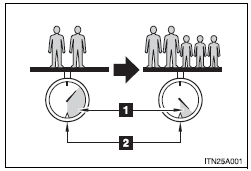Toyota Venza: Calculation formula for your vehicle

1. Cargo capacity
2. Total load capacity (vehicle capacity weight)
When 2 people with the combined weight of A lb. (kg) are riding in your vehicle, which has a total load capacity (vehicle capacity weight) of B lb. (kg), the available amount of cargo and luggage load capacity will be C lb. (kg) as follows:

In this condition, if 3 more passengers with the combined weight of D lb. (kg) get on, the available cargo and luggage load will be reduced E lb. (kg) as follows:

As shown in the example above, if the number of occupants increases, the cargo and luggage load equaling the combined weight of the occupants who got on later, by an amount. In other words, if an increase in the number of occupants causes an excess of the total load capacity (combined weight of occupants plus cargo and luggage load), you must reduce the cargo and luggage on your vehicle.
CAUTION
- Things that must not be carried in the luggage compartment
The following things may cause a fire if loaded in the luggage compartment.
• Receptacles containing gasoline • Aerosol cans
- Storage precautions
Observe the following precautions.
Failing to do so may result in death or serious injury.
• Do not place cargo or luggage in or on the following locations as the item may get under the brake or accelerator pedal and prevent the pedals from being depressed properly, block the driver’s vision, or hit the driver or passengers, causing an accident.
• Driver’s feet
• Front passenger or rear seats (when stacking items)
• Luggage cover
• Instrument panel
• Dashboard
• Auxiliary box or tray that has no lid
• Secure all items in the occupant compartment, as they may shift and injure someone during sudden braking, sudden swerving or an accident.
• Never allow anyone to ride in the luggage compartment. It is not designed for passengers. They should ride in their seats with their seat belts properly fastened. Otherwise, they are much more likely to suffer death or serious injury, in the event of sudden braking, sudden swerving or an accident.
CAUTION
- Weight of the load
• Do not exceed the maximum axle weight rating or the total vehicle weight rating.
• Even if the total load of occupant’s weight and the cargo load is less than the total load capacity, do not apply the load unevenly. Improper loading may cause deterioration of steering or braking control which may cause death or serious injury.
 Capacity and distribution
Capacity and distribution
Cargo capacity depends on the total weight of the occupants.
(Cargo capacity) = (Total load capacity) — (Total weight of occupants) Steps
for Determining Correct Load Limit—
(1) Locate the sta ...
 Vehicle load limits
Vehicle load limits
Vehicle load limits include total load capacity, seating capacity, Trailer
Weight Rating (TWR) and cargo capacity.
- Total load capacity (Vehicle capacity weight):
Total load capacity mean ...
Other materials about Toyota Venza:
Poor Sound Quality in All Modes (Low Volume)
PROCEDURE
1.
CHECK AUDIO SETTINGS
(a) Set treble, middle and bass to the initial values and check that the sound
is normal.
OK:
The sound returns to normal.
HINT:
Sound quality adjustment measures vary according to the ...
Driving the vehicle
The following procedures should be observed to ensure safe driving.
- Starting the engine
- Driving
With the brake pedal depressed,
shift the shift lever to “D”.
Release the parking brake.
Gradually release the brake pedal
and gentl ...
Problem Symptoms Table
PROBLEM SYMPTOMS TABLE
HINT:
Use the table below to help determine the cause of problem symptoms.
If multiple suspected areas are listed, the potential causes of the symptoms
are listed in order of probability in the "Suspected Area" ...
0.1549
